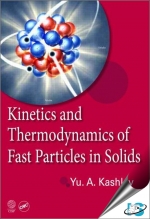Tab Article
Kinetics and Thermodynamics of Fast Particles in Solids examines the kinetics and non-equilibrium statistical thermodynamics of fast charged particles moving in crystals in different modes. It follows a line of research very different from traditional ways of constructing a theory of radiation effects, which gives a purely mechanistic interpretation of particle motion. In contrast, this book takes into account the thermodynamic forces due to separation of the thermodynamic parameters of the subsystem of particles ("hot" atoms) on the parameters of the thermostat (electrons and lattice), in addition to covering the various mechanisms of collisions.
Topics Include:
- Construction of a local kinetic equation of Boltzmann type for fast particles interacting with the conduction electrons and lattice vibrations, on the basis of the principles of Bogolyubov’s kinetic theory
- Calculation of the equilibrium energy and angular distributions of fast particles at a depth of the order of coherence length, and the evolution of particle distribution with increasing depth of penetration of the beam
- Calculation of transverse quasi-temperature of channeled particles with the heating of the beam in the process of diffusion of particles in the space of transverse energies, as well as cooling the beam through a dissipative process
- Research in the framework of non-equilibrium thermodynamics of the relaxation kinetics of random particles, including the thermodynamics of positronium atoms moving in insulators under laser irradiation
- Analysis of the kinetics of hot carriers in semiconductors and thermalization of hot carriers, as well as the calculation of the statistical distribution of ejected atoms formed during the displacement cascade
The book sets a new direction of the theory of radiation effects in solids - non-equilibrium statistical thermodynamics of fast particles—and aims to focus and aid the reader in the study of new areas of investigation in this area.


